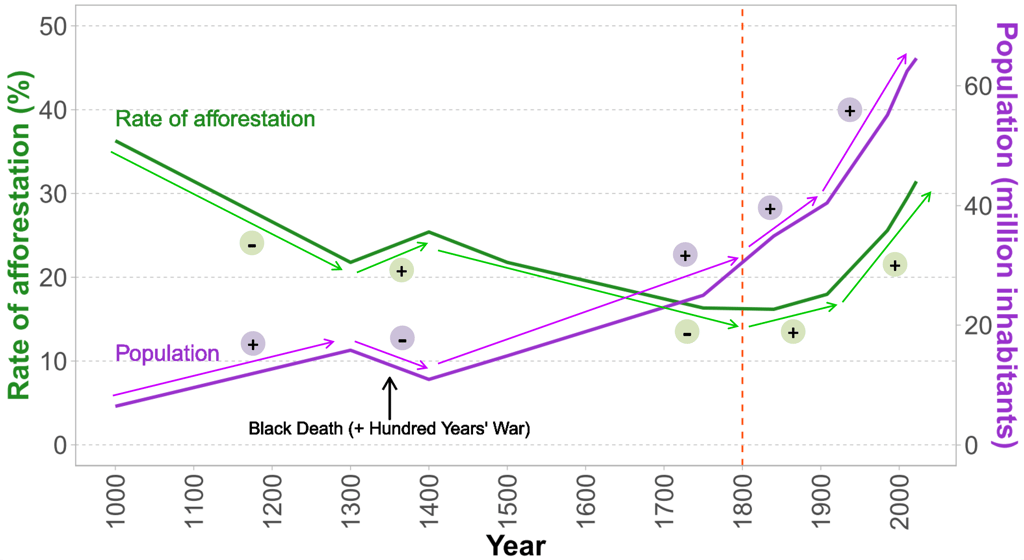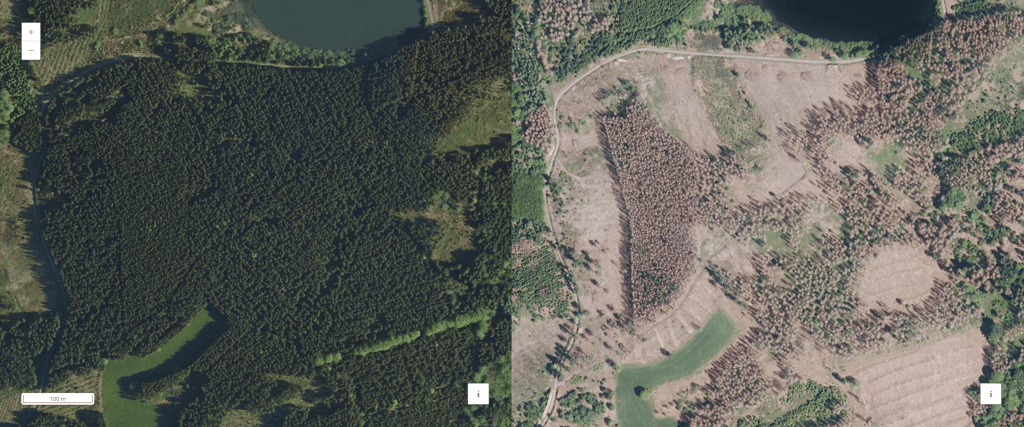
Articles on the Anthropocene
In-depth articles on the Anthropocene
A history of the French forest - Part 2
The recent history of the French forest as a witness to the upheavals linked to the exploitation of fossil resources
In the first part of this article devoted to the French forest, we showed how human activity has determined the forest area in mainland France over the millennia. An analysis of the combined evolution of human population and forest area over the course of history demonstrates the intimate link between population growth and deforestation. As the population of France has tended to increase over the centuries, the long-term dynamic of the French forest has been one of inexorable decline, until a forest minimum was reached after the French Revolution.
In this second part, we will focus on the dynamics of the French forest since the 19th century. In so doing, we'll show the extent to which the recent period constitutes a historical singularity, marked by a break in the age-old link between population growth and forest area decline. We will then discuss the new threats to the French forest, which, paradoxically, are precisely related to what has enabled the forest to regain ground in recent decades.
Fossil fuels at the bedside of France's forests
From the 19th century onwards, once the minimum forest area had been reached, something extraordinary happened: for the first time in the thousands of years of French history, the human population and the forest area increased in tandem, breaking the historical link between population growth and decline in forest area (Figure 1). Why is this so?


Figure 1: Trends in afforestation rate (ratio of forest area to total land area) and human population in France over the last millennium. Data sources: For the afforestation rate, data reconstructed from an article by Yves Birot for the period prior to 1840 [1] and the IGN memento for the period 1840-2022 [2]; For population, data from Our World in Data [3].
A first hypothesis can be formulated: given the vital nature of the forest, humans have become aware of the absolute necessity to halt forest regression and put in place the appropriate measures. Examples include the creation of the "École Nationale des Eaux et Forêts" in 1824, and the promulgation of the Forestry Code in 1827.
However, this conjecture is not very convincing. In previous centuries, numerous measures had already been taken to protect forest massifs, without succeeding in halting forest decline [4]. Why should the measures decided upon in the 19th century have suddenly succeeded where previous ones had failed?
In fact, far more than the implementation of effective political measures, the advent of fossil fuels has constituted a major turning point in favor of forest expansion. The exploitation of fossil resources has had a major impact on the surface required for food production and, in turn, on the surface available for forests.
By providing the energy necessary for the mechanization of practices and by constituting the raw material for the synthesis of various inputs (fertilizers, pesticides, etc.), fossil resources have multiplied agricultural yields in an extraordinary way; in other words, from the massive exploitation of fossil resources, much more food can be produced per unit of cultivated area.
As a result, the amount of agricultural land needed to provide food for human consumption has been considerably reduced, despite the demographic explosion that characterized the period and in particular the second half of the 20th century. Between 1950 and 2020, the area of farmland is estimated to have shrunk from almost 400,000 km2 (73% of the land area) to around 275,000 km2 (50% of the land area) [5], while the population has increased from just over 40 million to around 65 million [3]. Abandoned farmland is eventually colonized by forest and, to a lesser extent, by urbanization.
Although agricultural abandonment is an essential factor in forest expansion in France, it is not the only one. In addition to boosting agricultural yields, fossil fuels have provided a source of energy and materials to replace wood, which also contributes to reducing human pressure on forests. Finally, with the globalization of production chains (in other words, for a country like France, with the relocation of production to countries with slave labor), a large part of what the French population consumes now comes from industries that devour resources (and therefore space) located in foreign countries, which in a way amounts to delocalizing deforestation.
Ultimately, forest expansion can be seen as a luxury provided by the massive exploitation of fossil resources, rather than the result of conservation measures or "awareness". However, this luxury comes at a high cost: agricultural land, on which our food security depends, is in freefall, while the burning of fossil fuels itself poses major risks to forests and ecosystems as a whole.
A time of new threats
Fossil fuels have given the forest a welcome breathing space, halting its age-old decline and even paving the way for powerful forest expansion. However, their use has a few "minor drawbacks" which today pose considerable risks for the forest.
On the one hand, the use of fossil fuels, by enabling ever faster and more numerous means of transport, has led to a sharp increase in physical flows (of people and goods) around the world. These flows have led to the introduction of numerous exotic species into France, including tree pathogens. One example is the Hymenoscyphus fraxineus fungus, probably imported from Asia, which is responsible for significant mortality in ash trees (through a disease known as chalarosis).
On the other hand, the use of fossil fuels generates massive CO2 emissions. The increase in atmospheric CO2 may have had a beneficial effect on tree growth by stimulating photosynthesis [6, 7], but climate change could end up largely offsetting this fertilizing effect [8]. Climate projections show that trees (like us) will have to experience previously unknown and potentially unsustainable conditions.
Without even mentioning the future, the French national forest inventory survey highlights a sharp rise in forest tree mortality over the past decade [2], linked to a succession of seasons characterized by extreme and widespread drought.
Pathogens and extreme climatic events can act in concert, with the former delivering the "coup de grâce" to trees weakened by the latter. The extreme mortality observed in Norway spruce in recent years is due to an endemic xylophagous insect, the bark beetle, which has proliferated exceptionally due to mild winters, leading to the death of millions of Norway spruce trees weakened by successive droughts (Figure 2). In the final analysis, massive reliance on fossil fuels could be both the savior and, paradoxically, the executioner of the French forest.


Figure 2: Aerial photographs taken in 2008 (left) and 2020 (right) in the Haute-Saône department (northeast France). Between the two photo dates, Norway spruce trees that had been planted a few decades earlier have all died, victims of successive droughts and an attack by an insect pathogen known as bark beetles. Most of the dead spruces have already been cut down, leaving barren spaces, while others are still standing. Source of the image: IGN - Remonter le temps (https://remonterletemps.ign.fr/).
Forest is more than just trees
In this article, we have discussed the human influence on the forest, mainly in terms of forest area. However, the forest, a complex community of multiple interacting living organisms, is much more than just tree cover. It is therefore important to note that human influence is not limited to the modulation of forest area.
Without going into too much detail, over time mankind has largely influenced the composition of forests by favoring certain tree species over others, introducing new species (e.g. Douglas fir, originally from North America) or through massive plantations (e.g. maritime pine in the Landes region in southwest France), sometimes with species planted outside their natural range (e.g. the planting of Norway spruce in plains).
Humans have also profoundly altered the forest environment by developing a dense network of access routes (roads and paths), by massively frequenting the forest for various activities, and by modifying animal populations (species assemblages and population sizes) which influence forest functioning (e.g. tree regeneration). In many respects, the French forest can therefore be seen as an artificialized environment, which runs counter to the imaginary of deep naturalness associated with it.
Finally, a word about fires, which have received so much media coverage in recent years. Although they have a dramatic impact locally, fires, by destroying "only" a few thousand or tens of thousands of hectares of forest each year, ultimately have only a marginal impact on the dynamics of France's 17 million hectares of forest. In fact, contrary to popular belief, the area burned has tended to decrease in recent years in France [9]. Prevention and improved fire-fighting methods are two factors that have largely contributed to this decline, despite the spatial and temporal extension of the risk (fires can occur earlier or later in the season, and in hitherto unscathed regions) linked to rising temperatures and more frequent and intense drought episodes.
References
[1] Y. Birot, Les forêts et les hommes : quelles co-évolutions ?, in La Forêt et le Bois en France en 100 questions, 2015. https://www.academie-foret-bois.fr/chapitres/chapitre-1/fiche-1-05/
[2] IGN, Mémento, édition 2023. https://inventaire-forestier.ign.fr/IMG/pdf/memento_2023.pdf
[3] H. Ritchie et al., Population Growth, Our World in Data. https://ourworldindata.org/population-growth
[4] M. Chalvet, Une histoire de la forêt. Seuil, 2011.
[5] F. Bon, Préservation des terres agricoles : un rapport alerte sur l’urgence, Ouest-France, 2022. https://www.ouest-france.fr/economie/agriculture/preservation-des-terres-agricoles-un-rapport-alerte-sur-l-urgence-6eeb9bb4-8f28-11ec-91ef-c5100846ffb2
[6] D. Schimel, B. B. Stephens, et J. B. Fisher, Effect of increasing CO2 on the terrestrial carbon cycle, Proc. Natl. Acad. Sci., vol. 112, no 2, p. 436‑441, 2015. https://www.pnas.org/doi/10.1073/pnas.1407302112
[7] E. C. Davis, B. Sohngen, et D. J. Lewis, The effect of carbon fertilization on naturally regenerated and planted US forests, Nat. Commun., vol. 13, no 1, 2022. https://www.nature.com/articles/s41467-022-33196-x
[8] W. Hubau et al., Asynchronous carbon sink saturation in African and Amazonian tropical forests, Nature, vol. 579, no 7797, p. 80‑87, 2020. https://www.nature.com/articles/s41586-020-2035-0
[9] Observatoire des forêts françaises, Les incendies de forêt et de végétation. https://foret.ign.fr/themes/les-incendies-de-foret-et-de-vegetation
Conclusion
In addition to the millennia-old human influence on forest cover, discussed in the first part of this article, the break in the intimate link between population growth and deforestation following the advent of fossil fuels in the 19th century is another highlight in the history of the French forest. It shows that the energy and technological choices we make at a given time can have considerable repercussions on ecosystems for decades or centuries to come. Clearly, there is no such thing as a forest on one side and agricultural or urbanized land on the other, but rather a total interdependence between these different concepts that requires us to move away from the traditional compartmentalized vision.
The crucial impact of fossil fuel use on recent forest expansion also raises questions at a time when the challenge is to free ourselves from fossil fuels. Before the advent of fossil fuels, France's economy relied heavily on its wooded lands. The forest paid the price, even though the population and per capita consumption were much lower than they are today. The move away from fossil fuels towards forest biomass therefore seems utopian, given the insane appetite of our (over)consumer society.
While massive reliance on fossil resources has "saved" the French forest, it paradoxically poses considerable threats, via climate change and the introduction of pathogens, for example. Both the disadvantages of fossil fuels and the risks inherent in increased reliance on forest biomass ultimately argue for what looks like the path of wisdom: a drastic reduction in our material and energy consumption. A path our societies do not seem to consider at all. One thing is certain: humans have not finished shaping the French forest, for better or for worse.
Henri Cuny
